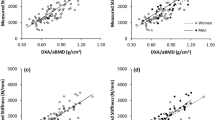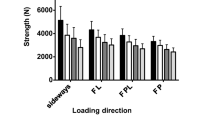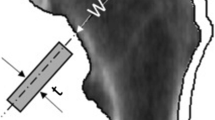Abstract
Precise quantification of femur strength and accurate assessment of hip fracture risk would help physicians to identify individuals with high risk and encourage them to take preventive interventions. A major contributing factor of hip fracture is the reduction of hip strength, determined by the bone quality. Bone mineral density (BMD) alone cannot determine bone strength accurately. In this paper, subject-specific quantitative computer tomography (QCT) image-based finite element analyses were conducted to identify the quantitative relationships between femoral strength and BMD, material distribution and geometric morphology. Sixty-six subjects with QCT data of hip region were selected from the MrOS cohorts in Hong Kong. Subject-specific nonlinear finite element models were developed to predict strengths of proximal femurs. The models took non-linear elasto-plasticity and heterogeneity of bone tissues into consideration and derived bone strengths with proper bone failure criteria. From finite element analysis (FEA), relationships between femoral strength and BMD, material distribution, and geometric parameters were determined. Results showed that FEA-predicted femoral strength was highly correlated with BMD, material distribution, height, weight, diameters of femoral head (HD), and femoral neck (ND), as well as the moment arm for femoral neck bending—offset (OFF). Through principal components analysis, three independent principal components (PCs) were extracted. PC1 was the component of bone material quality. PC2 included height, weight, HD, and ND. PC3 mainly represented OFF. Multivariate linear regression showed that the PCs were strongly predictive of the FEA-predicted strength. This study provided quantitative information regarding the contributing factors of proximal femur strength and showed that such a biomechanical approach may have clinical potential in noninvasive assessment of hip fracture risk.







Similar content being viewed by others
References
Bayraktar, H. H., E. F. Morgan, G. L. Niebur, G. Morris, E. Wong, and T. Keaveny. Comparison of the elastic and yield properties of human femoral trabecular and cortical bone tissue. J. Biomech. 37:27–35, 2004.
Bessho, M., I. Ohnishi, J. Matsuyama, T. Matsumoto, K. Imai, and K. Nakamura. Prediction of strength and strain of the proximal femur by a CT-based finite element method. J. Biomech. 40:1745–1753, 2007.
Boonen, S., R. Koutri, J. Dequeker, J. Aerssens, G. Lowet, J. Nijs, G. Verbeke, E. Lesaffre, and P. Geusens. Measurements of femoral geometry in type I and type II osteoporosis: differences in hip axis length consistent with heterogeneity in the pathogenesis of osteoporotic fractures. J. Bone Miner. Res. 10:1908–1912, 1995.
Boutroy, S., B. van Rietbergen, E. Sornay-Rendu, F. Munoz, M. Bouxsein, and P. D. Delmas. Finite element analysis based on in vivo HR-pQCT images of the distal radius is associated with wrist fracture in postmenopausal women. J. Bone. Miner. Res. 23(3):392–399, 2008.
Currey, J. D. Tensile yield in compact bone is determined by strain, post-yield behavior by mineral content. J. Biomech. 37:549–556, 2004.
Gong, H., M. Zhang, and Y. Fan. Micro-finite element analysis of trabecular bone yield behavior—effects of tissue non-linear material properties. J. Mech. Med. Biol. 11(3):563–580, 2011.
Hedia, H. S. Design of functionally graded dental implant in the presence of cancellous bone. J. Biomed. Mater. Res. B Appl. Biomater. 75:74–80, 2005.
Johnell, O., and J. A. Kanis. Epidemiology of osteoporotic fractures. Osteoporos. Int. 16:S3–S7, 2005.
Jolliffe, I. T. Statistics (2nd ed.). New York: Springer, 2002.
Kanis, J. A., L. J. Melton, C. Christiansen, C. C. Johnston, and N. Khaltaev. The diagnosis of osteoporosis. J. Bone Miner. Res. 9:1137–1141, 1994.
Keaveny, T. M., P. F. Hoffmann, M. Singh, L. Palermo, J. P. Bilezikian, S. L. Greenspan, et al. Femoral bone strength and its relation to cortical and trabecular changes after treatment with PTH, alendronate, and their combination as assessed by finite element analysis of quantitative CT scans. J. Bone Miner. Res. 23(12):1974–1982, 2008.
Keaveny, T. M., D. L. Kopperdahl, L. J. Melton, III, P. F. Hoffmann, S. Amin, B. L. Riggs, and S. Khosla. Age-dependence of femoral strength in white women and men. J. Bone Miner. Res. 25:994–1001, 2010.
Keyak, J. H. Improved prediction of proximal femoral fracture load using nonlinear finite element models. Med. Eng. Phys. 23:165–173, 2001.
Keyak, J. H., T. S. Kaneko, J. Tehranzadeh, and H. B. Skinner. Predicting proximal femoral strength using structural engineering models. Clin. Orthop. Relat. Res. 437:219–228, 2005.
Keyak, J. H., S. A. Rossi, K. A. Jones, and H. B. Skinner. Prediction of femoral fracture load using automated finite element modelling. J. Biomech. 31:125–133, 1998.
Keyak, J. H., S. Sigurdsson, G. Karlsdottir, D. Oskarsdottir, A. Sigmarsdottir, S. Zhao, et al. Male-female differences in the association between incident hip fracture and proximal femoral strength: a finite element analysis study. Bone 48(6):1239–1245, 2011.
Keyak, J. H., and H. B. Skinner. Three-dimensional finite element modeling of bone: effects of element size. J. Biomech. Eng. 14:483–489, 1992.
Lang, T., A. LeBlanc, H. Evans, Y. Lu, H. Genant, and A. Yu. Cortical and trabecular bone mineral loss from the spine and hip in long-duration spaceflight. J. Bone Miner. Res. 19(6):1006–1012, 2004.
Lv, L., G. Meng, H. Gong, W. Zhu, and X. Zhang. Effect of age on the three-dimensional morphologic parameters of proximal femurs. Bone 47:S416, 2010.
Lv, L., G. Meng, W. Zhu, H. Gong, D. Zhu, and X. Zhang. Relationships between the three-dimension morphologic parameters of proximal femurs. In: The 2010 3rd International Conference on Biomedical Engineering and Informatics, 2010, pp. 1353–1356.
Michelotti, J., and J. Clark. Femoral neck length and hip fracture risk. J. Bone Miner. Res. 14:1714–1720, 1999.
Niebur, G., M. Feldstein, J. Yuen, T. Chen, and T. Keaveny. High-resolution finite element models with tissue strength asymmetry accurately predict failure of trabecular bone. J. Biomech. 33:1575–1583, 2000.
Orwoll, E., J. B. Blank, E. Barrett-Connor, J. Cauley, S. Cummings, K. Ensrud, et al. Design and baseline characteristics of the osteoporotic fractures in men (MrOS) study—a large observational study of the determinants of fracture in older men. Contemp. Clin. Trials 26:569–585, 2005.
Orwoll, E. S., L. M. Marshall, C. M. Nielson, S. R. Cummings, J. Lapidus, J. A. Cauley, et al. Finite element analysis of the proximal femur and hip fracture risk in older men. J. Bone Miner. Res. 24:475–483, 2009.
Peacock, M., C. H. Turner, G. Liu, A. K. Manatunga, L. Timmerman, and C. C. Johnston. Better discrimination of hip fracture using bone density, geometry and architecture. Osteoporos. Int. 5:167–173, 1995.
Perillo-Marcone, A., A. Alonso-Wazquez, and M. Taylor. Assessment of the effect of mesh density on the material property discretisation within QCT based FE models: a practical example using the implanted proximal tibia. Comput. Methods Biomech. Biomed. Eng. 6:17–26, 2003.
Qin, Y. X., E. Mittra, W. Lin, Y. Xia, and R. Clinton. Non-invasive assessment of bone strength and density using scanning ultrasound. In: Proceedings of 2003 Summer Bioengineering Conference, USA, 2003, pp. 373–374.
Reilly, D. T., and A. H. Burstein. The elastic and ultimate properties of compact bone tissue. J. Biomech. 8:393–405, 1975.
Schileo, E., F. Taddei, L. Cristofolini, and M. Viceconti. Subject-specific finite element models implementing a maximum principal strain criterion are able to estimate failure risk and fracture location on human femurs tested in vitro. J. Biomech. 41:356–367, 2008.
Schuit, S. C., M. van der Klift, A. E. Weel, C. E. de Laet, H. Burger, E. Seeman, et al. Fracture incidence and association with bone mineral density in elderly men and women: the Rotterdam study. Bone 34:195–202, 2004.
Seeman, E., and P. D. Delmas. Bone quality—the material and structural basis of bone strength and fragility. N. Engl. J. Med. 354:2250–2261, 2006.
Taddei, F., L. Cristofolini, S. Martelli, H. S. Gill, and M. Viceconti. Subject-specific finite element models of long bones: an in vitro evaluation of the overall accuracy. J. Biomech. 39:2457–2467, 2006.
Trabelsi, N., and Z. Yosibash. Patient-specific finite-element analyses of the proximal femur with orthotropic material properties validated by experiments. J. Biomech. Eng. 133:061001, 2011.
Wainwright, S. A., L. M. Marshall, K. E. Ensrud, J. A. Cauley, D. M. Black, T. A. Hillier, et al. Hip fracture in women without osteoporosis. J. Clin. Endocrinol. Metab. 90:2787–2793, 2005.
Watari, F., A. Yokoyama, M. Omori, T. Hiraic, H. Kondoa, M. Uoa, and T. Kawasakia. Biocompatibility of materials and development to functionally graded implant for bio-medical application. Compos. Sci. Technol. 64:893–908, 2004.
Yosibash, Z., D. Tal, and N. Trabelsi. Predicting the yield of the proximal femur using high-order finite-element analysis with inhomogeneous orthotropic material properties. Philos. Trans. R. Soc. A 368:2707–2723, 2010.
Acknowledgments
MrOS is a project supported by the NIH USA (No. AR049439). This work is supported by The Hong Kong Polytechnic University Research Grants (No. G-U701), grants from National Natural Science Foundation of China (Nos. 10972090, 10832012 and 11120101001), and the Fundamental Research Funds for the Central Universities.
Conflict of interest
None.
Author information
Authors and Affiliations
Corresponding author
Additional information
Associate Editor Sean S. Kohles oversaw the review of this article.
Rights and permissions
About this article
Cite this article
Gong, H., Zhang, M., Fan, Y. et al. Relationships Between Femoral Strength Evaluated by Nonlinear Finite Element Analysis and BMD, Material Distribution and Geometric Morphology. Ann Biomed Eng 40, 1575–1585 (2012). https://doi.org/10.1007/s10439-012-0514-7
Received:
Accepted:
Published:
Issue Date:
DOI: https://doi.org/10.1007/s10439-012-0514-7




